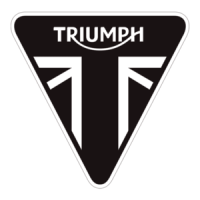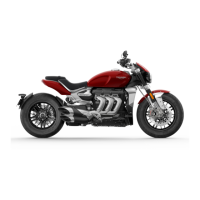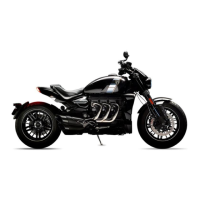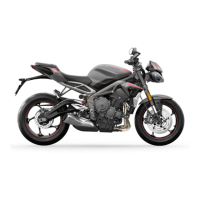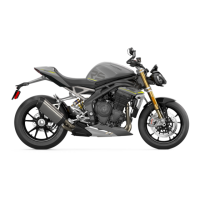Fuel System/Engine Management
Engine Management System
System Description
The Rocket
III
is
fitted with
an
electronic engine
management system which encompasses control of
both ignition
and
fuel delivery. The electronic control
module (ECM) draws information from sensors
positioned around the engine, cooling
and
air intake
systems
and
precisely calculates ignition advance
and
fueling requirements for all engine speeds
and
loads.
In
addition, the system has
an
on-board diagnostic
function. This ensures that, should a malfunction
occur
in
the engine management system, the
malfunction type,
and
engine data at the time the
malfunction occurred, are stored
in
the
ECM
memory.
This stored data can then
be
recovered using a
special service
tool
which
is
mandatory for
all
Triumph
dealers.
In
this
way,
precise diagnosis of a fault
can
be
made
and
the fault quickly rectified.
System Sensors
• Intake
air
temperature
sensor
- situated at the
front of the intake duct, above the cam
cover.
As
the density of the air (and therefore the amount
of oxygen available to ignite the fuel) changes
with temperature,
an
intake air temperature
sensor
is
fitted. Changes
in
air temperature (and
therefore air density) are compensated for
by
adjusting the amount of fuel injected
to
a
level
consistent with clean combustion
and
low
emissions.
• Barometric pressure
sensor
- situated beneath
the motorcycle seat,
in
the top of the airbox. The
barometric pressure sensor measures
atmospheric air pressure. With this information,
the amount of fuel per injection
is
adjusted
to
suit
the prevailing conditions.
• Manifold Absolute Pressure (MAP)
sensor
-
situated at the front of the intake duct, above the
cam
cover,
connected
to
each of the three
throttle bodies by equal length tubes. The MAP
sensor provides information to the
ECM
which
is
used at shallow throttle angles (very small
throttle openings)
to
provide accurate engine
load indications
to
the
ECM.
This degree of
engine load accuracy allows the
ECM
to make
very small adjustments
to
fuel and ignition which
would otherwise not
be
possible from throtlie
angle data alone.
• Clutch switch - situated
on
the clutch
lever.
The
clutch must
be
pulled
in
for the starter motor
to
operate.
• Crankshaft
position
sensor - situated
in
the
alternator
cover.
The crankshaft position sensor
detects movement of a toothed wheel attached
to
the alternator
rotor.
The toothed wheel gives a reference point from
which the actual crankshaft position
is
calculated. The crankshaft position sensor
information
is
used by the
ECM
to
determine
engine speed
and
crankshaft position
in
relation
to
the point where fuel
is
injected
and
ignition of
the fuel occurs.
• Engine coolant temperature
sensor
- situated
towards the front of the cylinder head, on the left
hand side. Coolant temperature information,
received
by
the
ECM,
is
used
to
optimise fueling
at
all
engine temperatures
and
to
calculate hot
and
cold start fueling requirements.
• Primary
throttle
position
sensor
- situated at
the rear of the lower throttle spindle. Used to
relay throttle position information
to
the ECM.
Throttle opening angle
is
used
by
the ECM
to
determine fueling
and
ignition requirements for
all throttle positions.
• Secondary throttle
position
sensor
- situated
at the front of the upper throttle spindle. Used
to
relay secondary throttle position information
to
the
ECM.
Secondary throttle angle
is
used
by
the
ECM
to
determine secondary throttle
opening position under
all
engine running
conditions.
• Road speed
sensor
- situated
in
the lower
crankcase,
on
the left hand side. The road
speed sensor provides the
ECM
with data from
which
road
speed
is
calculated
and
displayed
on
the speedometer. A vehicle speed limitation
device also receives information from the road
speed sensor.
• Lambda sensor - situated
in
the exhaust header
system upstream of the catalyst box. The
lambda sensor constantly feeds
in
formation
to
the
ECM
on
the content of the exhaust gases.
Based
on
this information, adjustments to air/fuel
ratio are made.
• Side stand switch - situated at the top of the
sidestand
leg.
If
the sidestand
is
in
the down
position, the engine will not
run
unless the
transmission
is
in
neutral.
11.16
Service Manual - Rocket
III
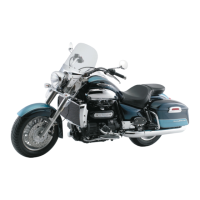
